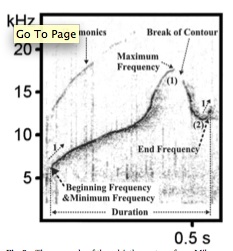Vocalization of Bottlenose Dolphins
Helen Magee, Biology 342 Fall 2007
Phylogeny
Vocalization in Dolphins and Other Species
To understand how dolphins developed the ability to vocalize through mimicry, it is important to consider the evolution of vocalization in other mammals. The only other mammal comparable to dolphins, in that they are able to not only vocalize but can mimic other sounds as well, are humans(1). Although humans and dolphins are not closely related speices, it is still useful to compare the two when consider the vocalization behavior because few species have this ability to mimic. The relationship between intelligence and the ability to vocally mimic is significant in the evolution of humans. Humans first had to develop the ability to mimic before they could communicate with languages, because in order to be able to use a combination of vocal sounds to communicate one must first be able to mimic the sounds, before any meaning can be associated with the combination of vocalizations.
Dolphins are also comparable to humans in that humans and dolphins have similar sized brains. As in the human brain, the brain of a dolphin has a denser region of cells in the thalamus. Also, cortical develop is parallel to that of a human brain. Based on the similarities between human and dolphin brains, one could conclude that dolphins are at a similar intelligence level to humans. However, there is also the opinion that there is no direct evidence to support the theory that similar brains size equates to similar intelligences levels(1). Figure 1 compares the dolphins brain to that of other species; the dolphins brain is similar in size to that of humans.
Figure 1: Brains of Dolphins and Other Species(3)

Other mammals that are known for vocalization are birds, but they generally do not show the same ability to vocally mimic that dolphins and humans do. However, when comparing the vocal abilities of dolphins to that of birds, it appears that the difference is more related to differences in the mechanics of vocalization in each of the two species, rather than a difference in intelligence(1).
How do differences in vocalizations among different populations of Bottlenose dolphins occur?
In a study of the difference between vocalizations of three Bottlenose dolphin population in the Indo-Pacific region, it was found that the vocalizations of these populations are significantly different. The three populations studied live off the Ogasawara Islands (OGA), off the Mikura Islands (MIK) and off the Amakusa- Shimoshima Islands. Figure 2 is a map of this region that shows where each of the populations are located.
Figure 2: Location of Three Populations of Bottlenose Dolphins(8)

The differences found in the vocalizations of each of the populations was in the frequencies of their whistles. To determine how the vocalizations of each population were different, they compared the frequencies of the dolphins' whistles at three different point over a .5 second duration. The compared the beginning freqencies( also the minumum frequency), the maximum frequency and the end frequency. It was found that the whistles of the AMA population had significantly lower maximum and end frequencies that the other two populations(8). Figure 3 is an example of a whistle with these three points shown.
Figure: Dolphin Whistle (8)

Possible explantions as to what causes these differences include ecological, gentic, social and historical factors(8). With the populations analyzed in this study, the differences were found to be due to variations in the geogrphaical locations of each of the populations(8).